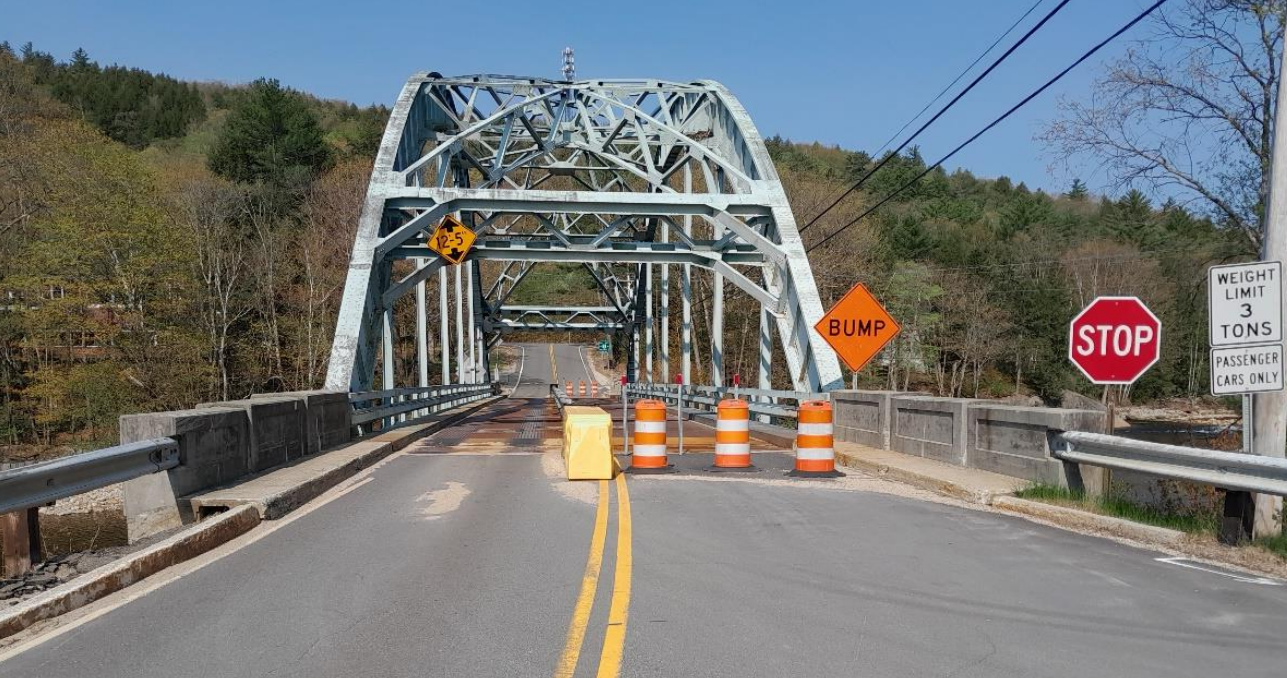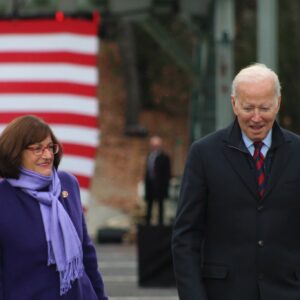On an icy morning in November 2021, then-President Joe Biden picked a tied-arch bridge with a rusty steel-grid deck spanning the Pemigewasset River in Woodstock to tout the trillion-dollar Infrastructure Investment and Jobs Act he’d just signed.
The 86-year-old iron relic, which funnels traffic in and out of North Woodstock, had been on New Hampshire’s red list of structurally unsafe bridges since 2014 — when Biden was serving as vice president.
Surrounded by the four Democrats in the state’s federal delegation, Biden stood at the foot of the bridge and pledged, “America is moving again, and your life is going to change for the better.”
And now, 1,234 days later, Biden’s gone, billions of dollars have been spent, and the bridge in Woodstock is still red-listed.

The bridge over the Pemigewasset River in Woodstock, N.H.
An average of 570 drivers navigating the bridge each day are greeted with a sign alerting them to its 3-ton limit, effectively barring commercial trucks.
According to J.D. Power, the average SUV — which constitutes half of all car sales in America – weighs about 5,000 pounds. And according to recent data, the average gross vehicle weight rating for most popular SUVS — which takes into account passengers, pets, and any other additions — frequently tops three tons.
For example, a Chevy Tahoe’s GVWR checks in at anywhere between 7,300 and 7,800 pounds.
“The deterioration of the open grid steel grading is accelerating, and we are now at a point where we need to restrict traffic to a single lane and down post the allowable loading further,” the New Hampshire Department of Transportation announced in a PowerPoint presentation to Woodstock town officials in May 2022.
It’s not just a New Hampshire problem.
For Kevan Stone, who heads the National Association of County Engineers, the question of which sector of national transportation infrastructure should worry Americans the most is obvious.
“It’s a very easy answer, and that is the state of bridges across the country,” Stone said during a recent infrastructure roundtable hosted by InsideSources. “Drive down a road, and a pothole is one thing. But if you’re traveling on a bridge, and that bridge goes when you’re on it, that’s as serious as it gets.”
Repairs to Woodstock’s 175-foot bridge are among the thousands that have yet to be made, a problem Dean Franks of the American Road and Transportation Builders Association told the roundtable that’s all too common.
“The way the infrastructure construction market works is that these things take time,” said Franks. “The whole ‘shovel ready’ term is antiquated because, for better or worse, we’re not using shovels anymore.”
New Hampshire has also been promised $200 million to address the lack of broadband connections for some rural residents. In fact, retiring U.S. Sen. Jeanne Shaheen (D-N.H.) has bragged about being the primary author of the $42.5 billion Broadband Equity Access and Deployment (BEAD) Program. It’s another part of the IJLA spending Democrats celebrated during the Biden presidency.
But at a March 5 meeting of the House Communications and Technology Subcommittee titled “Fixing Biden’s Broadband Blunder,” Chairman Richard Hudson (R-N.C.) pointed out that not a single household has been connected. Not just in New Hampshire, but in the entire country.
Shaheen has repeatedly declined to respond to reporters’ questions about the BEAD program, which critics say has been bogged down by liberal mandates regarding DEI and climate policy.
“The Biden administration is using this $42 billion program to pursue a climate change agenda, DEI requirements, technology biases, price controls, preferences for government-run networks, and rules that will undoubtedly lead to wasteful overbuilding. All of this will leave rural and other unconnected communities behind,” FCC Chairman Brendan Carr testified to Congress last summer.
Unlike a Wi-Fi connection, repairing or replacing Depression-era American bridges like Woodstock’s could be a matter of life and death, said Stone. He cited tragic bridge collapses such as Maryland’s Francis Scott Key Bridge a year ago.
The rebuilding project for the 8,630-foot Baltimore Harbor outer crossing is already underway, with a planned reopening date for the massive span set for the fall of 2028.
“We’re just not repairing (bridge infrastructure) at the state we should. It’s not being done at the expedience that it should, and funding is not the problem,” Stone said. “There are a million different reasons why it’s not being done, but it’s not being done, and it’s going to lead to tragedy, as history has shown us.”
And Franks said that though it’s been slow, progress is being made.
“We will hit a peak (with IIJA activities) in 2025-2027, even after the law has expired,” he said. “I would say the best is yet to come, and these things do take time.”
New Hampshire transportation officials told NHJournal that while the bridge in Woodstock remains “in the early stage of a rehabilitation project,” reconstruction is “set to begin this summer and will require one-way alternating traffic, with the bridge scheduled to close in early November.”





